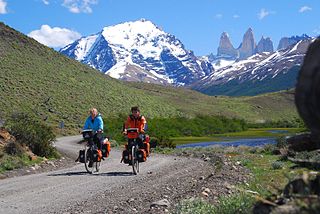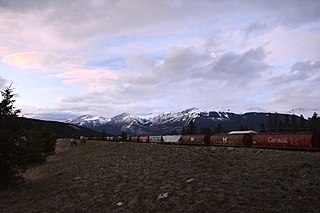
The Continental Divide National Scenic Trail is a United States National Scenic Trail running 3,100 miles (5,000 km) between Mexico and Canada. It follows the Continental Divide of the Americas along the Rocky Mountains and traverses five U.S. states — Montana, Idaho, Wyoming, Colorado, and New Mexico. In Montana it crosses Triple Divide Pass The trail is a combination of dedicated trails and small roads and considered 70% complete. Portions designated as uncompleted must be traveled by roadwalking on dirt or paved roads. This trail can be continued north into Canada to Kakwa Lake north of Jasper National Park by the Great Divide Trail.

The Trans Canada Trail, is a cross-Canada system of greenways, waterways and roadways that stretches from the Atlantic to the Pacific to the Arctic oceans. The trail extends over 24,000 kilometres ; it is now the longest recreational, multi-use trail network in the world. The idea for the trail began in 1992, shortly after the Canada 125 celebrations. Since then it has been supported by donations from individuals, corporations, foundations and all levels of government.
The Colorado Trail is a long-distance trail running for 486 miles (782 km) from the mouth of Waterton Canyon southwest of Denver to Durango in Colorado, United States. Its highest point is 13,271 feet (4,045 m) above sea level, and most of the trail is above 10,000 feet (3,000 m). Despite its high elevation, the trail often dips below the alpine timberline to provide refuge from the exposed, storm-prone regions above.

Alberta Provincial Highway No. 16, commonly referred to as Highway 16, is a major east–west highway in central Alberta, Canada, connecting Jasper to Lloydminster via Edmonton. It forms a portion of the Yellowhead Highway, a major interprovincial route of the Trans-Canada Highway system that stretches from Masset, British Columbia to Portage la Prairie, Manitoba, near Winnipeg. Highway 16 spans approximately 634 km (394 mi) from Alberta's border with British Columbia in the west to its border with Saskatchewan in the east. As of 2010, all but less than 96 km (60 mi) of the route was divided, with a minimum of two lanes in each direction. It is designated a core route in Canada's National Highway System.
U.S. Bicycle Route 76 is a cross-country bicycle route east of Kansas in the United States. It is one of the two original U.S. Bicycle Routes, the other being U.S. Bicycle Route 1. U.S. Bicycle Route 76 runs from the Midwestern state of Missouri to the eastern seaboard state of Virginia. It is also known as the TransAmerica Bike Route.
The Golden Triangle is a major 330 km cycling route located in western Canada along the border between British Columbia and Alberta, forming a triangle with Lake Louise, Golden and Radium Hot Springs as its points. It crosses the continental divide twice, through the Kicking Horse Pass between Lake Louise and Golden, and the Vermilion Pass between Radium Hot Springs and Lake Louise. The Triangle can be "extended" by riding to Jasper on the Icefields Parkway from Lake Louise. At its highest points the trail reaches elevations of 1640 m.

The Great Divide Trail (GDT) is a wilderness hiking trail in the Canadian Rockies situated in Canada. The trail closely follows the Great Divide between Alberta and British Columbia, crossing the divide no fewer than 30 times. Its southern terminus is in Waterton Lakes National Park at the Canada–US border and its northern terminus is in Kakwa Provincial Park north of Jasper National Park. The trail is 1,130 km (700 mi) long and ranges in elevation from 1,055 m (3,461 ft) at Old Fort Point trailhead near Jasper to 2,590 m (8,500 ft) at an unnamed pass above Michele Lakes just south of the White Goat Wilderness Area.
The Pacific Crest Bicycle Trail (PCBT) is a 2,500-mile-long, road-based bicycle touring route from Vancouver, British Columbia, Canada to Tijuana, Baja California, Mexico. It was designed to closely parallel the Pacific Crest Trail and the two trails cross 27 times as they pass through the states of Washington, Oregon, and California.
The Western Express Bicycle Route is a 1582-mile (2546 km) bicycle touring route that connects San Francisco, California, to the TransAmerica Bicycle Trail in Pueblo, Colorado, traveling through California, Nevada, Utah, and Colorado. The route is mapped by the Adventure Cycling Association. Combining the Western Express Route with the TransAmerica Trail forms a 3762-mile (6054 km) transcontinental bicycle route through nine U.S. states from San Francisco, California, to Yorktown, Virginia.
The Lewis & Clark Bicycle Trail is a bicycle touring route created by Adventure Cycling Association to commemorate the bicentennial of the 1804-1806 Corps of Discovery Expedition. The route follows the path of Meriwether Lewis and William Clark as they explored the Louisiana Purchase and the Pacific Northwest.

Bikecentennial '76 was an event consisting of a series of bicycle tours on the TransAmerica Bicycle Trail across the United States in the summer of 1976 in commemoration of the bicentennial of America's Declaration of Independence. The route crossed ten states, 22 national forests, two national parks, and 112 counties between Astoria, Oregon, and Yorktown, Virginia, a distance of about 4,250 miles (6,840 km). The route was chosen to take cyclists through small towns on mostly rural, low-traffic roads.

A long-distance trail is a longer recreational trail mainly through rural areas used for hiking, backpacking, cycling, horse riding or cross-country skiing. They exist on all continents except Antartica.
Mixed terrain cycle touring, nicknamed "rough riding" in North America and "rough stuff" in Europe, involves cycling over a variety of surfaces and topography on a single route, with a single bicycle. The recent popularity of mixed terrain touring is in part a reaction against the increasing specialization of the bike industry. Focusing on freedom of travel and efficiency over varied surfaces, mixed terrain bicycle travel has a storied past, one closely linked with warfare. By comparison, today’s mixed terrain riders are generally adventure oriented, although many police departments rely on the bicycle’s versatility. In many remote parts of the world with unreliable pavement, the utility bicycle has become a dominant form of mixed terrain transportation. A new style of travel called adventure cycle-touring or expedition touring involves exploring these remote regions of the world on sturdy bicycles designed for the purpose. Off-road adventure cycling with lightweight gear, and often a rackless system, is now known as bikepacking. Bikepacking is not a new phenomenon though, as light weight - soft luggage touring has been in use for well over a century. Early settlers in Australia used bicycles with bags strapped to the handlebars, frame, and under the saddle to carry loads into the Australian outback.

Detroit is a popular city for cycling. It is flat with an extensive road network with a number of recreational and competitive opportunities and is, according to cycling advocate David Byrne, one of the top eight biking cities in the world. The city has invested in greenways and bike lanes and other bicycle-friendly infrastructure. Bike rental is available from the riverfront and tours of the city's architecture can be booked.
The Great Divide Mountain Bike Route (GDMBR) is a 3,083.8 mi (4,962.9 km), off-road bicycle touring route between Banff, Alberta, Canada and Antelope Wells, New Mexico, USA. Completed in 1997, the GDMBR was developed by Adventure Cycling Association, who continue to maintain highly-detailed route maps and a guidebook.
U.S. Bicycle Route 50 (USBR 50) is a west–east U.S. Bicycle Route. It consists of three sections: a western section from South Lake Tahoe, California, to Border, Utah; a Midwestern section from just outside Terre Haute, Indiana, to Steubenville, Ohio; and an eastern section from Colliers, West Virginia, to Washington, D.C. The route is ultimately planned to span the country, from near San Francisco to Washington, D.C.
The Adventure Cycling Route Network, developed by Adventure Cycling Association since 1974, comprises 46,846 miles of routes for bicycle touring in the U.S. and Canada and is the largest such network in North America.
The TransAmerica Bicycle Trail was the first bicycle touring route to cross the U.S. It was developed and mapped by Adventure Cycling Association, and travels between Astoria, Oregon, and Yorktown, Virginia, along mostly rural, two-lane highways.








